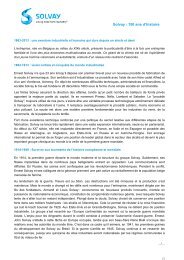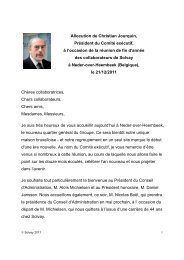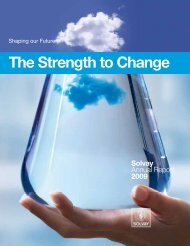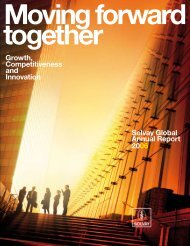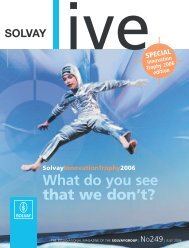You also want an ePaper? Increase the reach of your titles
YUMPU automatically turns print PDFs into web optimized ePapers that Google loves.
organized in November 2007 –<br />
each developed on a cross-entity<br />
basis and some involving external<br />
partnerships – also highlighted the<br />
wide range of possible applications.<br />
Grouping and synthesizing of this<br />
knowledge and expertise within<br />
one and the same entity, and then<br />
re-disseminating it throughout<br />
the Group is without doubt the<br />
best way of generating even more<br />
synergies. It also promotes interdisciplinary<br />
cooperation, which<br />
is a vital factor in the creation of<br />
innovative products.<br />
The five award-winning<br />
projects:<br />
• development of materials for<br />
the new generation of liquid<br />
crystal displays (LCDs) and<br />
very high resolution thin film<br />
transistors (TFT);<br />
• better distribution of nanocomposites<br />
in very high<br />
temperature polymers;<br />
• analysis of the effects of<br />
nanoparticles on the properties<br />
of polyamides;<br />
• incorporation of nanoparticles<br />
in certain polymers as early as<br />
possible in the manufacturing<br />
process;<br />
• integrating nanostructures in<br />
fuel cell catalysts.<br />
2007, a year full in<br />
high-level events,<br />
honored by the<br />
contributions of<br />
Nobel prize-winners<br />
In September, <strong>Solvay</strong> NBD and the<br />
Center for Organic Photonics and<br />
Electronics (COPE) of the Georgia<br />
Institute of Technology, Atlanta<br />
(USA) organized at Metz (France)<br />
the 9 th European conference on<br />
Molecular Electronics.<br />
The 350 participants included three<br />
Nobel prize-winners in Chemistry<br />
as well as representatives from the<br />
most prestigious research institutes<br />
of Europe, the USA and Asia.<br />
Professor Jean-Marie Lehn, from<br />
the Université Louis Pasteur at<br />
Strasbourg (France), holds the 1987<br />
Nobel Prize for Chemistry, for his<br />
body of work on hollow molecules.<br />
As far back as 1968 he synthesized<br />
three-dimensional hollow molecules<br />
able to englobe cations (cryptands),<br />
marking the start of what he himself<br />
named supramolecular chemistry.<br />
Alan Heeger of the Department of<br />
Physics, University of California<br />
at Santa Barbara, Santa Barbara,<br />
CA (USA), was awarded the Nobel<br />
Prize for Chemistry in 2000 for<br />
“the discovery and development<br />
of conductive polymers”.<br />
Robert R. Grubbs of the California<br />
Institute of Technology, Pasadena,<br />
CA (USA), was awarded the Nobel<br />
Prize for Chemistry in 2005 for<br />
his work on the “development of<br />
metathesis in organic synthesis”.<br />
In November, the third edition of<br />
the “<strong>Solvay</strong> Science for Innovation”<br />
conference took as its subject<br />
“Building up complex<br />
materials: from nanoscale<br />
to end-use properties”.<br />
During these three working<br />
days, some 200 researchers<br />
New Business Development<br />
and managers from within the<br />
Group were able to better identify<br />
and understand the differing<br />
relationships between the<br />
nanometric structures and final<br />
properties of <strong>Solvay</strong> materials and<br />
products, and to compare our<br />
current knowledge with the latest<br />
outside developments in this area.<br />
These Science Days were honoured<br />
with presentations by Professor<br />
Jean-Marie Lehn (see above) and<br />
by Professor Robert Laughlin, of<br />
Stanford University, Stanford, CA<br />
(USA), who took the Nobel Prize in<br />
Physics in 1988 for the discovery of<br />
an electronic effect now known as<br />
the “fractional quantum Hall effect”.<br />
This conference ended with the<br />
award of prizes, including<br />
EUR 200 000 support grants to<br />
each of the five projects considered<br />
by a board of specialists to be the<br />
most innovative and to offer the<br />
highest potential value to the Group.<br />
Also in May 2007, 25 young<br />
researchers from Brussels<br />
universities received prizes at the<br />
15 th <strong>Solvay</strong> Awards ceremony.<br />
The ensuing science afternoon<br />
focused around two eminent<br />
academics, Professor Stephen<br />
Hawking, Lucasian Professor of<br />
Mathematics, Cambridge (UK),<br />
mathematician, astrophysicist<br />
and philosopher, a specialist in<br />
the infinitely large, and Sir Harold<br />
Kroto, University of Sussex (UK),<br />
Nobel Prize in Chemistry 1996, who<br />
discovered fullerenes, which are<br />
new carbon nanostructures with<br />
unsuspected and highly promising<br />
properties.<br />
New Business<br />
Development<br />
<strong>Solvay</strong> Global Annual Report 2007<br />
53


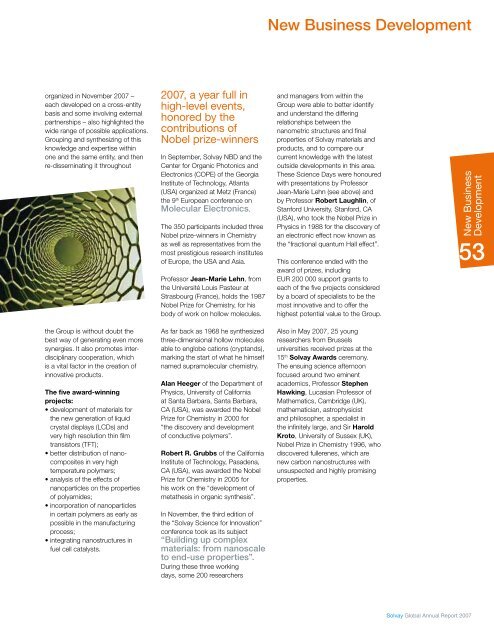

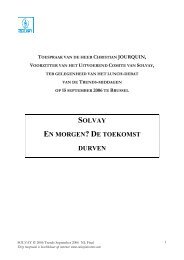
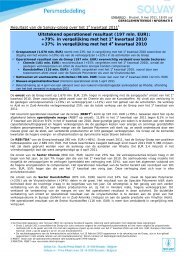

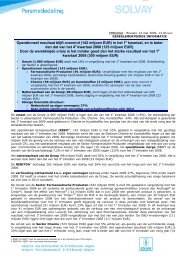
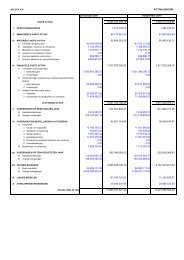

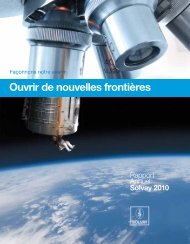
![PROC.1 [LETTRE] - Solvay](https://img.yumpu.com/16585746/1/184x260/proc1-lettre-solvay.jpg?quality=85)
